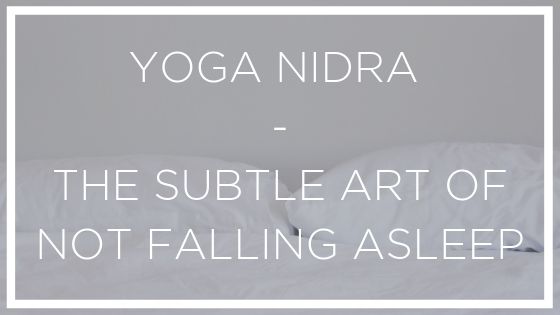Many people are aware of the importance of good sleep hygiene, some are even aware of alternative sleep practices such as polyphasic sleep or lucid dreaming. The practice of yoga nidra has grown in popularity over the recent decades and provides a new way of experiencing deep restoration of the body with new states of consciousness.
In our normal awake state, our brain is in a beta wave pattern, and when we fall into dreaming sleep, it enters a theta brain wave pattern. Between these two states, we briefly enter what is called the hypnagogic state of an alpha brain wave pattern. This typically only lasts 3-5 minutes before we continue into sleep.
Yoga nidra is the art of entering into this in-between state consciously and remaining alert for extended periods, before returning back to the awake state. The trick is to not fall asleep as our body and mind experience deep relaxation.
You can think of it as the state of being between consciousness and dreaming. The practice is learning to lengthen this period, letting your body enter deeper states of relaxation while keeping your mind from succumbing to sleep.
History Of Yoga Nidra
The first time the term yoga nidra appears is in the ancient epic ‘The Mahābhārata’. These references though are not to a particular technique but instead a state of transcendental sleep experienced by gods and goddesses.
In more recent yogic texts the word came to be synonymous with the word ‘samadhi’ and used in reference to states of deep meditation.
Swami Satyananda Saraswati is responsible for bringing this ancient practice into modern day use. Through the studying and practice of ancient tantric practices, he took what he saw to be the essence of these without the ritualistic drawbacks.
He developed this trademark technique in the early 1960s, as part of the Bihar School of Yoga. It is likely he was inspired by western relaxation therapy as well, his guru Swami Sivananda teaching a form of progressive relaxation. What resulted is a modern amalgamation of ancient tantric practices with modern relaxation techniques.
How To Practice Yoga Nidra
Yoga Nidra requires roughly half an hour of your time, and to begin you will need a teacher. Don’t worry. These days we are blessed to have free recordings of hundreds of teachers online. I will link to some at the bottom of the page.
Unlike meditation, which requires a focused concentration of the mind, yoga nidra requires a more fluid approach. Of your five senses, all are closed off and turned inwards except sound. The sound of your teachers becomes the guide for your journey into your own unconscious.
While it is important to listen to the voice, it is also natural to lose focus at times. Do not worry though, the words are still reaching you beyond your conscious mind. Just bring your attention back to the words when you catch yourself drifting. This too will help you from falling asleep.
The best time to practice yoga nidra is in the early morning, or at night before bed. Preferably on an empty stomach, in a temperate room well ventilated, but not breezy.
To prepare yourself, come into savasana (corpse pose) with your limbs spaced out to your side and palms up to the sky.
Technique of Yoga Nidra
While the exact details of each yoga nidra session will vary, there is a general framework that you can expect the session to run through. Beginning once you have become settled in savasana.
Sankalpa
This is a resolve or intention that you are encouraged to make. This can be for anything you wish, although it is encouraged to be positive or divine qualities in yourself. Literally, the word translates to ‘vow towards your higher self’. Similar to modern affirmations, the resolution should be framed positively and be concise.
Rotation of Consciousness
You will then be guided through your body with words. As each word is spoken you should visualise and mentally recite the body part. This can be done slowly, or quite rapidly depending on the session. Particular focus is given to the region of the hands and face. This is due to a large amount of the brain that is mapped to these sensitive areas.
Awareness of Breath
Similar to breath meditation, your awareness will be guided to take in all the subtle sensations of the breath. Noticing the regions involved, the traits of the breath, visualisation of the breath and counting of the breath.
Experience of Contrasting Emotions/Feelings
Here you will be encouraged to fully realise the experience of contrasting feelings. This is likely to include the feeling of heaviness/lightness, heat/cold/ pain/pleasure. The more fully you can recreate the sensations of each, the more powerful the effect will be on your consciousness.
Visualisation of Imagery
At this point, your body is likely to be in a deeply relaxed state, and your conscious awareness hanging on by the thread of auditory sensation. You will likely be asked to check you are still awake. Then proceeding the teacher will begin saying words that you must vividly imagine in your mind. These can include images such as cloudy night sky, boat in the ocean, snowcapped mountain tops, lotus flower on a lake, etc. Alternatively, it may be a story that you are too visualise in detail.
Conclusion
Before returning to your awakened state, it is encouraged to return again to your sankalpa and recite in mentally again. This time programming it deeper in the subconscious. Gradually returning to a seated position with eyes open.
Benefits of Yoga Nidra
Perhaps the clearest benefit of yoga nidra is its effect on mental health. Studies have shown that daily practice has a significant effect of decreasing self-reported feelings of stress and anxiety. With an increased dopamine release of 65%.
We also have a clearer understanding of what occurs within the brain during yoga nidra. Brain scans have shown that the pre-frontal cortex that is active during the day shuts down. The regions at the rear of the brain that are responsible for visualisation and experience of emotions begin to light up. These are the same areas that switch on when we sleep.
Promising results have also been shown for people dealing with PTSD, insomnia, chronic pain and depression. Yoga nidra requires no physical movement and as such is a very safe practice for almost everyone.
Yoga nidra is also a deeply personal experience. The benefits you attain will likely be particular to your current mental/physical state and environment. The setting of an intention allows you to meditate on and work towards your own personal goals. While visualisations will likely reveal things about yourself that are unique to only you.

Hi, I am Matt. I am a passionate student of health and wellness. The science of yoga is the most effective system I’ve yet found for bringing about physical vitality with mental clarity. By blending a Western approach of anatomy and alignment, with Eastern philosophies and meditative techniques. My mission is to share these modern and ancient teachings to help others find harmony in their life.
